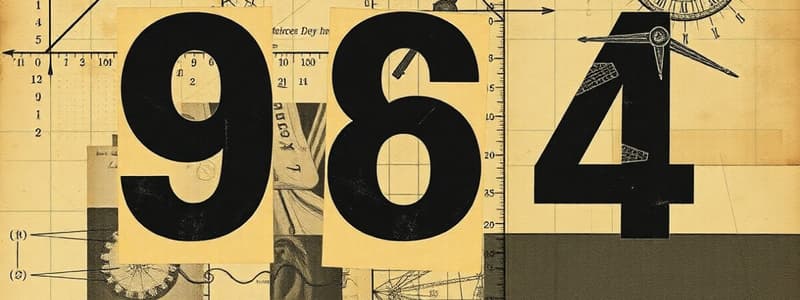Podcast
Questions and Answers
What is the correct formula for calculating the area of a triangle?
What is the correct formula for calculating the area of a triangle?
- Area = (base + height) / 2
- Area = base × height
- Area = (base × height) / 2 (correct)
- Area = 2 × (base + height)
Which measure of central tendency represents the middle value in a data set?
Which measure of central tendency represents the middle value in a data set?
- Median (correct)
- Mode
- Range
- Mean
What is the greatest common divisor (GCD) of 24 and 36?
What is the greatest common divisor (GCD) of 24 and 36?
- 18
- 8
- 12
- 6 (correct)
What type of angle is greater than 90 degrees but less than 180 degrees?
What type of angle is greater than 90 degrees but less than 180 degrees?
In coordinate geometry, what does the slope represent?
In coordinate geometry, what does the slope represent?
Which of the following is a rational number?
Which of the following is a rational number?
Which of the following graphs best represents frequency data?
Which of the following graphs best represents frequency data?
Which property relates to the calculation of the perimeter of a rectangle?
Which property relates to the calculation of the perimeter of a rectangle?
What represents an arithmetic sequence?
What represents an arithmetic sequence?
Which of the following shapes has no vertices?
Which of the following shapes has no vertices?
Flashcards
Prime Numbers
Prime Numbers
Whole numbers greater than 1 that have only two factors: 1 and themselves.
LCM
LCM
The smallest number that is a multiple of two or more numbers.
Algebraic Expressions
Algebraic Expressions
Mathematical phrases involving variables and constants.
Linear Equation
Linear Equation
Signup and view all the flashcards
Geometric Shapes
Geometric Shapes
Signup and view all the flashcards
Perimeter
Perimeter
Signup and view all the flashcards
Area
Area
Signup and view all the flashcards
Volume
Volume
Signup and view all the flashcards
Mean
Mean
Signup and view all the flashcards
Probability
Probability
Signup and view all the flashcards
Study Notes
Number Theory
- Understand and perform operations with integers, fractions, decimals, and percentages.
- Identify prime numbers, factors, and work with ratios, proportions, least common multiple (LCM), and greatest common divisor (GCD).
- Understand rational and irrational numbers, and solve problems involving exponents and square roots.
Topics:
- Prime Numbers, Composite Numbers, and Factorization
- Least Common Multiple (LCM) and Greatest Common Divisor (GCD)
- Fractions, Decimals, and Percentages
- Ratios, Proportions, Rational, and Irrational Numbers
- Exponents and Square Roots
Activities:
- Prime factorization exercises
- LCM and GCD problem sets
- Fraction, decimal, and percentage operations practice
- Ratio and proportion problem-solving
- Solving problems involving exponents and roots
Algebra
- Simplify and evaluate algebraic expressions.
- Solve linear and quadratic equations, including inequalities.
- Recognize patterns and sequences, understand functions.
Topics:
- Algebraic Expressions and Simplification
- Solving Simple Linear and Quadratic Equations
- Linear Inequalities and Graphing
Geometry
- Recognize and apply properties of geometric shapes (triangles, quadrilaterals, circles).
- Calculate perimeter, area, surface area, and volume of shapes.
- Understand and apply theorems related to triangles, circles, and coordinate geometry.
Topics:
- Properties of Rectangles, Squares, Triangles, and Circles
- Perimeter, Area, Surface Area, and Volume Calculations
- Introduction to Angles (Acute, Obtuse, Right)
- Theorems Related to Triangles and Circles
- Coordinate Geometry (Plotting Points, Slopes)
Activities:
- Draw, measure, and solve problems involving geometric shapes
- Calculate area, perimeter, and volume using real-life scenarios
- Apply geometric theorems to solve problems
- Practice plotting and analyzing points on a coordinate plane
Data Handling
- Organize, interpret, and analyze data using various graphs and charts.
- Calculate measures of central tendency and understand basic to advanced probability concepts.
Topics:
- Collecting Data, Creating Bar Graphs, Pictographs, and Line Graphs
- Measures of Central Tendency (Mean, Median, Mode)
- Data Interpretation from Complex Graphs (e.g., Pie Charts)
- Measures of Dispersion (Standard Deviation)
- Probability Concepts (Basic to Advanced)
Activities:
- Create and interpret bar graphs, line graphs, and pie charts
- Analyze data sets to find mean, median, mode, and standard deviation
- Solve basic and advanced probability problems
Problem Solving Strategies
- Apply logical reasoning and develop strategies for complex problem-solving.
- Prepare for Olympiad-style questions through advanced practice.
Topics:
- Logic Puzzles and Riddles
- Introduction to and Advanced Mathematical Proofs
- Mathematical Reasoning Techniques
- Olympiad-style Problem Sets
Activities:
- Solve logic puzzles and work on advanced problem sets
- Practice mathematical proofs with guided examples
- Participate in mock Olympiad exams
Studying That Suits You
Use AI to generate personalized quizzes and flashcards to suit your learning preferences.




